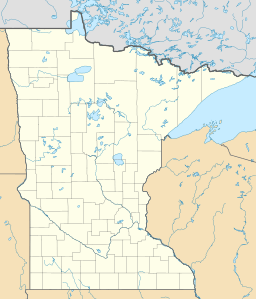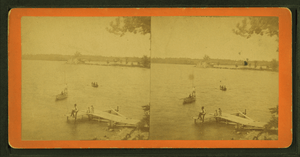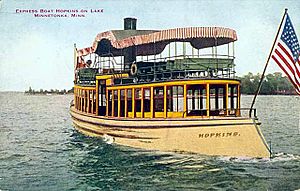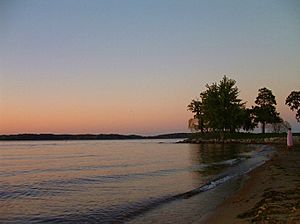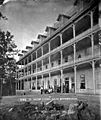Lake Minnetonka facts for kids
Quick facts for kids Lake Minnetonka |
|
|---|---|
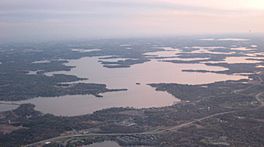 |
|

Map
|
|
| Location | Hennepin and Carver counties, Minnesota, United States |
| Coordinates | 44°56′00″N 93°34′00″W / 44.93333°N 93.56667°W |
| Primary inflows | Six Mile Creek |
| Primary outflows | Minnehaha Creek |
| Basin countries | United States |
| Surface area | 14,528 acres (5,879 ha) |
| Max. depth | 113 ft (34 m) |
| Shore length1 | 125 mi (200 km) |
| Surface elevation | 929 ft (283 m) |
| Islands | Big Island Crane Island |
| Settlements | Deephaven Excelsior Greenwood Minnetonka Minnetonka Beach Minnetrista Mound Orono Shorewood Spring Park Tonka Bay Victoria Wayzata Woodland |
| 1 Shore length is not a well-defined measure. | |
Lake Minnetonka (which means "the-water-they-speak-of-is-large" in the Dakota language) is a large lake in Minnesota. It's about 15 miles (24 km) southwest of Minneapolis. The lake is in Hennepin and Carver counties and is surrounded by 13 towns and cities.
At 14,528 acres (5,879 ha), Lake Minnetonka is Minnesota's ninth largest lake. It's a very popular spot for boating, sailing, and fishing. Many people live in beautiful homes around the lake.
Contents
Discovering Lake Minnetonka's Past
Who Lived Here First?
The first people to live around Lake Minnetonka were Paleo-Indians, who arrived about 8,000 years ago. Later, between 3500 BCE and 1500 CE, people known as "Mound Builders" lived here. They built large earth mounds for spiritual events, ceremonies, burials, and homes. This culture was strongest around 1150 CE but ended by 1500 CE.
By the 1700s, the Mdewakanton people, a group of the Dakota Nation, lived near Lake Minnetonka. They often visited the lake to hunt, fish, and gather wild rice and maple sap. A place called Spirit Knob, near today's Wayzata, was very important to them. After the Dakota War of 1862, the Dakota people had to leave Minnesota.
The first European Americans to visit Lake Minnetonka were two teenagers, Joe Brown and Will Snelling, in 1822. They canoed from Fort Snelling. For the next 30 years, not many other Europeans visited the lake.
How Lake Minnetonka Got Its Name
Minnesota's governor, Alexander Ramsey, officially named Lake Minnetonka in 1852. He learned that the Dakota people called it Mní iá Tháŋka, meaning "the-water-they-speak-of-is-large." The first European settlement, Excelsior, was started the next year.
The first steamboat on the lake, the Governor Ramsey, was launched in 1861. But it was still hard to get to the lake until a railroad line reached Wayzata in 1867.
Peter Gideon, an early plant expert, moved to the Lake Minnetonka area in 1853. In 1868, he successfully grew a new type of apple that could survive Minnesota's cold winters. He named it the "Wealthy" apple after his wife. This discovery helped lead to other famous apples like the Haralson and Honeycrisp apples.
Lake Minnetonka's "Glory Years"
During the 1870s and early 1880s, many hotels and boarding houses were built near Lake Minnetonka. The Hotel Saint Louis in Deephaven opened in 1879 with 150 rooms. The even bigger Lake Park Hotel opened in Tonka Bay later that year.
The largest hotel ever built on Lake Minnetonka was the Hotel Lafayette in Minnetonka Beach, which opened in 1882. It was nearly 800 feet (244 m) long and five stories tall, with space for over 400 guests. Many visitors came from the southern United States to enjoy the lake's beauty and cooler weather during the summer.
Large steamboats also became popular. The City of Saint Louis, the first inland steamboat with electric lights, started service in 1881. The biggest boat, Belle of Minnetonka, launched in 1882. It was 300 feet (91 m) long and could carry up to 2,500 passengers!
The Minnetonka Yacht Club, the lake's first yacht club, was started in Deephaven in 1882. One of its founders, Hazen Burton, helped create the racing scow. When his first racing scow, Onawa, debuted in 1893, it won almost every race. It was so fast that it was first disqualified! But eventually, the rules changed, and racing scows became popular worldwide. You can see Onawa today at the Excelsior-Lake Minnetonka Historical Society Museum in Excelsior.
By the 1890s, people started finding new vacation spots as railroads expanded. This caused many of Lake Minnetonka's hotels and steamboats to close. Most were taken down or burned. However, by 1900, more families began building private summer cottages around the lake. Larger permanent homes and grand country estates also started to appear as the Twin Cities grew. Some of these old homes still exist today.
Lake Minnetonka's "Golden Years"
In 1905, the Twin City Rapid Transit Company (TCRT) extended a streetcar line to Excelsior. In 1906, TCRT opened Big Island Park on Big Island and started its Express Boat service. These "streetcar boats" were like floating streetcars. Seven steamboats connected 26 landings around the lake to Excelsior, where passengers could catch a streetcar to the Twin Cities. Many people used these boats to commute to work. Tourists could also take ferry boats to Big Island Park for picnics, music, and rides. However, TCRT closed Big Island Park in 1911 because it was too expensive to run.
As roads improved in the early 1920s, fewer people rode the streetcar boats. By 1926, TCRT stopped all steamboat service on the lake. To get rid of the boats, TCRT sank three of them in deep water north of Big Island. The others were scrapped or sold. Streetcar service to Excelsior continued until 1932.
Crane Island, an island on the western side of the lake, became a popular spot for summer cottages in 1907. Many of the island's original cottages are still there, and it is now a historic district listed on the National Register of Historic Places.
Several famous country clubs, like the Lafayette Club, Minnetonka Country Club, and Woodhill Country Club, were also started during this time.
Lake Minnetonka in the Late 20th Century
Fred W. Pearce, a well-known amusement park operator, opened Excelsior Amusement Park in Excelsior in 1925. It had a fun house, rides like the Silver Streak and Scrambler, a carousel, and a roller coaster called the Cyclone. The famous band The Rolling Stones performed there in 1964. The park was a popular tourist spot until it closed in 1973. Today, there are apartments and a restaurant on the site.
Before they became famous in the 1940s, the singing group The Andrews Sisters spent their summers with family in Mound. They often returned to the area later in life.
In 1946, Mound Metalcraft started in Mound. The company changed its name to Tonka Toys in the 1950s and became famous for making toy trucks. Tonka Toys was bought by Hasbro in 1991 and is no longer based in Minnesota.
In 1965, two strong tornadoes hit the Lake Minnetonka area. They caused a lot of damage in Mound, Navarre, and Deephaven. Many homes and businesses were destroyed.
The steamboat Minnehaha, one of the streetcar boats that was sunk in 1926, was brought up from the bottom of the lake in 1980. It was restored and returned to service in 1996. Today, the Museum of Lake Minnetonka operates the Minnehaha, carrying passengers between Excelsior and Wayzata, just like it did over a century ago.
All About Lake Minnetonka's Water
How Lake Minnetonka Was Formed
Lake Minnetonka was formed about 10,000 years ago when a huge ice sheet melted and moved north. The lake is actually many smaller lakes connected by channels and marshlands. This gives it an unusual shape and 125 miles (201 km) of shoreline. Lake Minnetonka has 18 islands.
The lake is split into two parts: the Upper Lake in the west and the Lower Lake in the east. Water flows from west to east in the lake's watershed. The deepest part of Lake Minnetonka is 113 feet (34 m) deep in Crystal Bay. The lake's average depth is about 30 feet (9 m). With a surface area of 14,528 acres (5,879 ha), it's the ninth largest lake in Minnesota.
Water Flow and Levels
Several streams flow into Lake Minnetonka, with Six Mile Creek being the largest. The only place water flows out of the lake is through Minnehaha Creek. Near the eastern end of the lake, the Grays Bay Dam helps keep the water level at an average of 929 feet (283 m) above sea level.
The amount of water flowing over the dam changes, from none to 300 cubic feet (8.5 m³) per second. This means up to 193,881,600 US gallons (734,000 m³) can flow out each day. A lot of water also evaporates from the lake, sometimes as much as 50 million US gallons (189,000 m³) per day.
The lake typically freezes over with 12 to 18 inches (30 to 46 cm) of ice during winter. The average date for the ice to melt completely ("ice-out") is April 14. This date has been recorded since 1855. The earliest ice-out was March 11, 1878, and the latest was May 8, 1856. In early August, the water temperature usually reaches its highest, around 80°F (26.7°C).
Fish and Other Animals
Lake Minnetonka is home to many types of fish, including black bullhead, black crappie, bluegill, common carp, largemouth bass, muskellunge, northern pike, walleye, and yellow perch. There are some guidelines for eating certain fish from the lake.
According to local stories, a very large sturgeon, over 10 feet (3 m) long, has lived in Lake Minnetonka for many years. People have reported seeing this sturgeon, often called "Lou," since the 1980s. In 2019, two boys caught a large sturgeon in Minnehaha Creek. The Minnesota DNR thought it might have come from Lake Minnetonka.
Protecting Lake Minnetonka's Environment
People started worrying about Lake Minnetonka's environmental issues when curly-leaf pondweed was found in 1900. Later, purple loosestrife was found in 1940, and Eurasian water milfoil in 1987. Zebra mussels were discovered in 2010. These are all invasive species that can harm the lake's ecosystem.
In the past, Lake Minnetonka had a lot of pollution from sewage, fertilizer, and runoff. Conditions have gotten much better since the 1970s, but pollution from fertilizer and runoff is still a concern. The water quality is now carefully watched.
Sometimes, some of Lake Minnetonka's beaches might close temporarily if there are high levels of certain bacteria.
Three different groups help protect Lake Minnetonka's environment: the Minnehaha Creek Watershed District, the Lake Minnetonka Conservation District, and the Minnesota Department of Natural Resources.
Fun Things to Do at Lake Minnetonka
Lake Minnetonka has many popular restaurants. Al & Alma's Supper Club and Charter Cruises, founded in Mound in 1956, is the oldest restaurant and cruise line on the lake. Lord Fletcher's in Spring Park has been popular since 1968. Maynards Restaurant in Excelsior, opened in 1998, is another favorite waterfront spot. Downtown Excelsior and Wayzata have become great places for food, with many new restaurants opening.
The Old Log Theater in Greenwood opened in 1940. It's Minnesota's oldest professional theater. Famous actors like Nick Nolte and Loni Anderson have performed there.
Lake Minnetonka has several regional parks managed by Three Rivers Park District. The biggest are Lake Minnetonka Regional Park in Minnetrista and Noerenberg Gardens in Orono. Three Rivers Park District also has two regional bike trails near the lake. Other large public parks include Big Island Nature Park and the Excelsior Commons.
Boating, sailing, and fishing are the most common activities on Lake Minnetonka. You can launch boats of all sizes, but there are rules about speed and noise. The lake has four active yacht clubs and a group for antique and classic boats. Several companies offer larger boat cruises, like Al & Alma's 83-foot (25 m) Bella Vista. These cruises often highlight the beautiful homes around the lake.
Other fun activities on Lake Minnetonka include swimming, kayaking, and standup paddleboarding in the summer. In the winter, people enjoy ice fishing, snowmobiling, and ice yachting.
Several community festivals happen around the lake each year. Some of the bigger events are James J. Hill Days in Wayzata, Apple Day in Excelsior, and the Spirit of the Lakes Festival in Mound.
Images for kids


